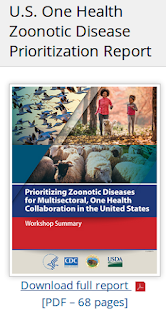#14,052
Zoonotic diseases - those which originated in or are normally hosted by non-human species - but can spill over into humans - have been with us for thousands of years. Tuberculosis probably jumped to humans when we began to domesticate goats and cattle 5000 years ago. Measles appears to have evolved from canine distemper and/or the Rinderpest virus of cattle.
And Influenza, which is native to aquatic birds, became much more of a threat after humans domesticated ducks, geese, and chickens.The list of zoonotic diseases is long and continues to expand, and includes such well known infections as SARS, MERS, Babesiosis, Borrelia (Lyme), Nipah, Hendra, Malaria, Dengue, Zika, Hantavirus, Ebola, Bartonella, Leptospirosis, Q-Fever, several flavors of avian flu and many, many others.
These emerging infectious diseases are considered such an important threat that the CDC maintains as special division – NCEZID (National Center for Emerging and Zoonotic Infectious Diseases) – to deal with them.
In 2014, in Emerging zoonotic viral diseases L.-F. Wang (1, 2) * & G. Crameri wrote:
The last 30 years have seen a rise in emerging infectious diseases in humans and of these over 70% are zoonotic (2, 3). Zoonotic infections are not new. They have always featured among the wide range of human diseases and most, e.g. anthrax, tuberculosis, plague, yellow fever and influenza, have come from domestic animals, poultry and livestock. However, with changes in the environment, human behaviour and habitat, increasingly these infections are emerging from wildlife species.All of which explains our focus in this blog on zoonotic threats, and serves as prelude to the following media release from the CDC on a newly published One Health Zoonotic Disease Prioritization report, which can be downloaded from the link below.
I'll return with a postscript after the break.
8 Zoonotic Diseases Shared Between Animals and People of Most Concern in the U.S.
First-ever CDC, USDA, DOI collaborative report lists top-priority zoonoses for U.S.
Media Statement
For Immediate Release: Monday, May 6, 2019
Contact: Media Relations
(404) 639-3286
The Centers for Disease Control and Prevention (CDC) and its U.S. government partners have released the first federal collaborative report listing the top zoonotic diseases of national concern for the United States. Zoonotic diseases are illnesses that can spread between animals and people.
The CDC, U.S. Department of the Interior (DOI), and U.S. Department of Agriculture (USDA) developed the report after jointly hosting a One Health Zoonotic Disease Prioritization Workshop for the United States. During the workshop, agencies agreed on a list of eight zoonotic diseases that are of greatest concern to the nation and made recommendations for next steps using a One Health approach.
“Every year, tens of thousands of Americans get sick from diseases spread between animals and people. CDC’s One Health Office is collaborating with DOI, USDA, and other partners across the government to bring together disease detectives, laboratorians, physicians, and veterinarians to prevent those illnesses and protect the health of people, animals, and our environment,” said Casey Barton Behravesh, M.S., D.V.M., Dr.P.H., director, One Health Office, CDC.
The zoonotic diseases of most concern in the U.S. are:
Six out of every 10 infectious diseases in people are zoonotic, which makes it crucial that the nation strengthen its capabilities to prevent and respond to these diseases using a One Health approach. One Health is an approach that recognizes the connection between people, animals, plants, and their shared environment and calls for experts in human, animal, and environmental health to work together to achieve the best health outcomes for all.
- Zoonotic influenza
- Salmonellosis
- West Nile virus
- Plague
- Emerging coronaviruses (e.g., severe acute respiratory syndrome and Middle East respiratory syndrome)
- Rabies
- Brucellosis
- Lyme disease
This workshop was the first time multiple government agencies in the United States worked together on this topic and is a critical step towards a coordinated U.S.-specific approach to One Health. The workshop report outlines the process, the resulting list of prioritized zoonotic diseases, and discussions and recommendations by the participants.
This report is a new resource for organizations that work on One Health issues, the media, and other stakeholders and includes recommendations on how to work together to address the prioritized diseases and strengthen One Health efforts in the United States.
The U.S. One Health Zoonotic Disease Prioritization report is available online: https://www.cdc.gov/onehealth/domestic-activities/us-ohzdp.html
These threats represent the current top 8 zoonotic threats to the United States, but as the appendix below illustrates, they are far from alone. Ebola comes in as #16, and Monkeypox lands at #29 on the list. Crimean-Congo Hemorrhagic Fever sits at #15, and Nipah is 20th.
Over time, some of these threats may rise in the ranks, while others may fall. A lot depends on how well they are controlled or contained elsewhere in the world.
In this highly connected 21st century, nothing happens in a vacuum.
For more on the connections between human and animal health, and the environment, you may wish to visit the CDC's ONE HEALTH website:
One Health
One Health recognizes that the health of people is connected to the health of animals and the environment. It is a collaborative, multisectoral, and transdisciplinary approach—working at the local, regional, national, and global levels—with the goal of achieving optimal health outcomes recognizing the interconnection between people, animals, plants, and their shared environment.

